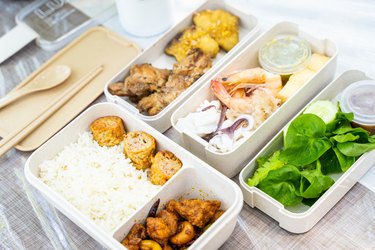
Cleaning plasticware can be tricky. The more that the item is scrubbed by hand with abrasive sponges or exposed to the harsh temperatures and water pressure of the dishwasher, the more the item is subjected to small nicks and scratches. These tiny divots and scratches on the plastic's surface can be a potential problem as food particles find a way to stain or create bacterial issues within the tubs and lids.
Not all plastic is dishwasher safe, and not all plastic dishes or glasses are marked to show they are dishwasher safe. That is up to the manufacturer. For cold food to keep its safe frigid temperatures, and hot foods to remain at a desirable warmth, it is important to know the limits of plastic containers.
Video of the Day
Video of the Day
Plastic Problems in the Dishwasher
Some fear that the hot water in the dishwasher or the high temperatures in the microwave can degrade the plastic and cause harmful chemicals to leach into the food or otherwise expose the contents of the plastic containers to cancer-causing chemicals.
The Food and Drug Administration banned the use of bisphenol A, or BPA, in baby bottles, food containers and similar plastic products for consumer use. However, Consumer Reports explains that if the plastic item you are placing in the appliance isn't clearly labeled as dishwasher safe, then you run the risk of ruining the structure of the container as well as exposing users of the item to unhealthy chemicals.
Plastic in Dishwasher
When the temperature is too high for the particular plastic, it can warp, distort or discolor the plastic. Even labeled as dishwasher safe, some plastic food containers can suffer damage overtime. Polycarbonate can be weakened when repeatedly put through the harsh water pressure and high temperatures of a dishwasher's interior.
The dishwasher-safe symbol looks like two circles under slanted lines, while the food-safe symbol looks like a glass and fork next to each other. The microwave-safe plastic symbol can be found on the underside of plates and bowls, the back of dinnerware and side or bottom of cups and other containers.
Plastics Safe for Food Containers
In general, the three most common plastics that are used for food storage lids and containers are polypropylene, high-density polyethylene and low-density polyethylene. Each of these is top rack safe and can be run in the dishwasher. The LDPE plasticware has a lower temperature rating than others.
Although they stress that most foods should be heated and consumed from glass containers, Nontoxic Revolution lists different types of commonly used plastic and their characteristics.
- High-density polyethylene — Typically opaque, HDPE is used for milk containers, juice bottles, detergent tubs and more.
- Polyvinyl chloride — PVC is used for clingy film to wrap food and cooking oil bottles and should not be placed in the microwave or dishwasher. It is not heat resistant and will more than likely warp.
- Polyethylene terephthalate — PETE, or PET, is clear and makes up the bulk of disposable beverage bottles.
- Polypropylene — This is typically used in condiment bottles, medicine containers and premade containers labeled microwave safe. It is heat resistant. The polypropylene food safe temperature is 210 degrees Fahrenheit.
- Polystyrene — Styrofoam should never be placed in the dishwasher or microwave.